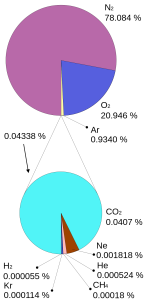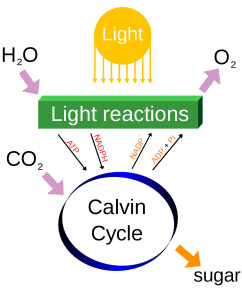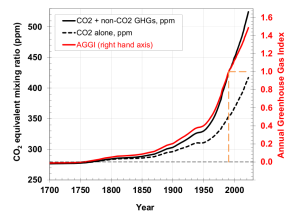NOTE TO READERS
The following basic explanation of the science of climate change, extracted from my book Inhabiting Eden: Christians, the Bible, and the Ecological Crisis, was written in 2012. Important situational changes that have taken place in the years since are noted in red.
One of the most important things we can do is to have climate conversations, i.e., to talk with others about climate change and what we hope to gain by stemming it. We do not need to explain the science to do so. This excerpt is simply offered in lay terms for those interested in a bit of background.
Carbon and Energy

We all know that different solids and fluids have differing properties. Gold, iron, calcium, carbon, and sulfur are all solid elements, but we can see, feel, and in some cases smell the differences among them. Similarly, though oxygen, nitrogen, argon, and carbon dioxide are all invisible gases, they too differ in behaviors. Most of the atmosphere is nitrogen (78 percent) and oxygen (20 percent). Argon comes next (1 percent). These three gases are simple: N2, O2, and Ar. Sunlight passes through them as if they were not there.
But the next most prevalent gas is carbon dioxide, CO2. As a more complex molecule, it absorbs the sun’s infrared light, trapping heat. This reality, which can be demonstrated by simple experiments, is called the “greenhouse” effect, and carbon dioxide is called a greenhouse gas. Other greenhouse gases are methane (CH4), water vapor (H2O), nitrous oxide (N2O), ozone (O3), and a variety of chemically complex human-made gases such as CFCs and HFCs.
The more greenhouse gases there are in the lower atmosphere, or troposphere, the more sunlight is absorbed, warming the air. This is why Venus, whose atmosphere is more than 96 percent CO2, has a surface air temperature of nearly 900 degrees F. As long as the concentration of greenhouse gases in the earth’s troposphere remains within a narrow range, they benefit us, warming the air to temperatures that support life.

Most life depends on plant photosynthesis. Energy from the sun interacts in plants with water and carbon dioxide to create carbohydrates such as glucose, with oxygen emitted as a byproduct (6CO2 + 6H2O + light energy à C6H12O6 + 6O2). These organic carbon molecules store energy throughout the plant. When plants and those who have eaten plants respire, they reverse the photosynthetic process that stored the energy, releasing it for their own use.
The carbon in the earth’s atmosphere is only a fraction of all the carbon on earth. The atmosphere contains 700 gigatons (Gtons, each a billion metric tons) of carbon. The land surface contains about 500 Gtons in living beings (plants, animals) and 1,500 Gtons in dead carbon in the soils. The ocean contains even more: the living carbon tissues are only one Gton, but the oceans contain an additional 600 Gtons of dissolved organic matter and a whopping 38,000 Gtons of dissolved inorganic carbon.
But the vast majority of carbon is found in sedimentary rocks such as limestone (CaCO3): more than 1,000,000 Gtons. And sequestered with these rocks are the fossil fuels we mine for energy use: 5,000 Gtons. When these are burned for power, the chemical reaction releases carbon to the atmosphere, where it joins with oxygen to create CO2. If we could burn all the fossil fuel that exists, we would add to the atmosphere all 5,000 Gtons, which is more than seven times more than is there currently, with a proportionate increase in atmospheric warming. It would use up all the oxygen, but first it would become too hot for survival.

We burn fossil fuels for the same reason we eat—to get the solar energy stored in carbon molecules. One gallon of gasoline consists of carbon created by ninety-eight tons of algae and plankton that sank to the ocean’s bottom and were covered, pressurized, and cooked over millions of years. “All the green the planet grows in four hundred years wouldn’t quite produce the fossil fuels we burn in one,” terrestrial ecologist Jeffrey Dukes estimates. In the past century, enough fossil carbon has been released to increase the atmospheric ratio of CO2 by more than 40 percent: from 260–280 parts per million (ppm) in preindustrial times to around 400 ppm today. [NOTE: April 2024 level is 427 ppm] During ice ages the CO2 concentration was as low as 180–200 ppm. In other words, CO2 levels today are further from preindustrial levels than those were from ice-age levels. We’ve created a heat age.
A century ago scientists predicted that releasing carbon into the atmosphere would cause temperatures to rise. Today climate scientists say that if our activities continue unchecked, the atmosphere’s average temperature will rise by seven degrees Celsius (about 12 degrees Fahrenheit) by the end of this century. [NOTE: More recent modeling suggests a worst-case scenario of 5.7 degrees C by 2100, still far out of any acceptable range.]
The difference such an increase will make is huge. The last ice age was only five or six degrees cooler than now. Plants and animals, including ourselves, are adapted to the climate that exists and can’t move or adapt fast enough to survive such dramatic change. Since adaptations differ among species that depend on one another, natural cycles are falling out of sync. Bees will be unavailable to pollinate vegetables, fruits, and other plants on which we depend. The berries on which some birds rely will not be available for them. The rains will not come when the seed is in the ground, as we saw in the summer of 2012 throughout the Midwest. And so on.

Seven degrees C is the average temperature rise, but the greatest rise, scientists say, is at the earth’s poles. The measured rise in average global temperature is, so far, only 0.6 degrees C, less than a tenth of what is anticipated. [NOTE: For the first time, in 2023, the world surpassed rise of 1.5 degrees C.] But already the northern ice cap is melting. Water sequestered as snow and ice in Antarctica and Greenland, as it melts, is already causing sea levels to rise. Glaciers and mountain snow that provide drinking water for billions of people are already receding, leading to drought. Some places that were receiving rainfall are drier, and places already dry are becoming parched. In sub-Saharan Africa, for instance, the desert region is expanding, leading to famines. As cropland is lost and rain forests are destroyed for new fields, tens of thousands of species are disappearing every year.
It helps to distinguish between climate and weather. Weather, as we know, changes day by day, and a weather forecast even a week in advance is inaccurate. So we may wonder how, if scientists can’t predict weather for a week, they can predict climate for a century. It has to do with averages. When we toss a coin, we can only with fifty-percent accuracy predict how it will land. But if we toss a hundred coins, if we guess that about half will land heads up, we have a much greater chance of being right. Climate is the sum total of average weather trends over the course of a decade or more. That is why, though the trend in average temperature has been upward, with nine of the ten warmest years since 1880 having occurred since 2000, no one knows whether any particular year will follow that trend in every place.

Until recently, scientists have hesitated to blame any particular weather event on climate change. But as droughts, floods, extreme highs and lows, and violent storms increase, this reluctance is changing. In a peer-reviewed study published in August 2012, NASA scientist James Hansen used statistical analysis to show that three recent climate events—the 2003 heat wave in Europe that killed tens of thousands, the 2010 heat wave in Russia and the Middle East that killed thousands, and the 2011 drought in Texas and Oklahoma—were caused by climate change.
Some argue that sunspots are driving temperatures up. Sunspots do appear to be able to affect the climate. But if they were the driving force now, it would be the stratosphere, nearer to the sun, that would be warming. Instead the warming is near the surface, where we and all life are. Sunspot activity over the past thirty years has continued its usual variable cycle, with no trend upward or downward.
Annual worldwide fossil fuel usage currently emits 7 Gtons of carbon. About 2 Gtons are absorbed by land and plants, and another 2 Gtons by the ocean. Three Gtons remain, warming the air. Over time both the land and the ocean are becoming less able to absorb these large amounts of carbon. In the meantime, the ocean’s absorption of CO2 is increasing its acidity, damaging marine life. Climatologists say we cannot allow temperatures to rise past two degrees C, and that the oceans are acting as a heat sink, delaying this rise. [NOTE: The limit now adopted by the Intergovernmental Panel on Climate Change (IPCC) is 1.5 degrees C, a limit we have already reached.] The effects will catch up more slowly, like the crash at the end of a long rush downhill.
In sum, scientists claim that: 1) climate change is occurring; 2) it is caused by greenhouse gases from human activity, particularly fossil fuel burning; and 3) as the temperature rises, the carefully balanced ecosystem on which we depend is endangered.
